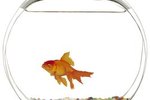
When the lives of your fish are at stake, choosing the right medication is a critical and difficult decision. Methylene blue can remedy various ailments, including bacterial illness and parasite infestation. While it's a relatively safe chemical, its application has associated risks, and treatment isn't always effective.
Take Notes
Before pursuing any form of treatment for your aquarium, consider making a detailed list of all of its inhabitants. Note the size, species and quantity of each animal in the tank. Write down the tank's specifications, including total size and filter type. Be sure to document the appearance of any disease symptoms or the presence of foreign organisms in your tank. Refer to the notes when you discuss your situation with an expert who can help you make an informed decision about using methylene blue on your fish.
Quarantine Tanks Are Preferred
Methylene blue is generally recommended as a bath or dip treatment -- don't put it directly to your aquarium unless your vet advises to do so. It is a powerful phytotoxin, which means it attacks most types of bacteria and other micro-organisms indiscriminately, even the beneficial ones. This is a primary reason why dosing the aquarium instead of a quarantine tank is a risk. The chemical is true to its name: It will stain the inside of your tank. Move your fish to a temporary holding tank before conducting bath or dip treatments.
Treating the Aquarium
In some cases, treating the main aquarium is the only way to address the problem at hand. An expert may instruct you to treat your primary tank directly, if you use methylene blue, to reverse chemical poisoning or combat external parasites. In this case, you should remove the live carbon filter to preserve the bacteria inside, replacing it later. Install an temporary mechanical filter during the treatment process.
Adding the Blue
Apply methylene blue to your tank according to the directions on the product packaging if not according to the advice of your local fish expert. Note the difference between the instructions for freshwater and saltwater. The chemical comes in liquid form inside a dropper bottle and in a concentrated dry powder. The general rule for direct aquarium application is to add 1 drop of liquid methylene blue or 1 teaspoon of powdered mixture per 10 gallons of water. Mix 1 teaspoon of the medication for every 5 gallons of water to create marine dip solutions for saltwater fish. Dissolve methylene blue powder with a small amount of water before adding it to the tank.
Observation and Post-Care
As with any treatment, keep close tabs on your tank after applying methylene blue. Replace about a quarter of your aquarium's water and replace the carbon filter after three to five days. Methylene blue is often effective at reducing pathogens, but it may not eradicate parasites entirely. Be prepared to seek more specific treatment to extirpate the disease or parasite plaguing your aquarium. Look for signs of the disease returning in the following weeks.
References
Photo Credits
-
Photodisc/Digital Vision/Getty Images
Writer Bio
Quentin Coleman has written for various publications, including All Pet News and Safe to Work Australia. He spent more tan 10 years nursing kittens, treating sick animals and domesticating semi-feral cats for a local animal shelter. He graduated from the University of Delaware with a bachelor's degree in journalism.




